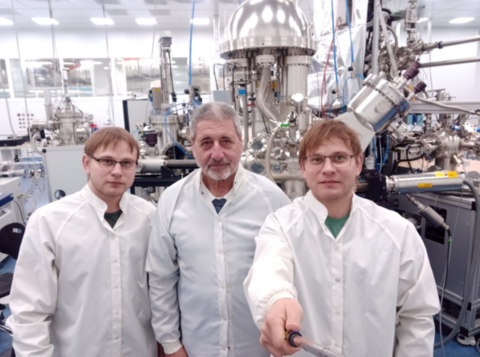Research fellows of the Crystal Growth Laboratory of the SUSU "Non-conventional Materials and Resource-Saving Technologies" Research Institute have successfully completed the experiment held at the National Research Centre "Kurchatov Institute". They studied the products of chemical and radiation-induced carbonization of the films of fluorine-containing polymer polyvinylidene fluoride (PVDF). The results of this experiment provided the scientists with crucial information, which will help create a new semiconducting material in the future.
PVDF is a multi-purpose industrial material that can be used to manufacture components for petrochemical, chemical, metallurgical, food, paper-making, textile, semiconductor, pharmaceutical, and nuclear sectors. This polymer has been created quite some time ago, but the SUSU researchers are modifying it through its exposure to chemical agents or radiation. After the modification, a new material is obtained, which is then studied using the method of photoelectron spectroscopy.
The research is being conducted within the frameworks of the strategic project on the Fundamentals of the Synthesis and Operation of Non-conventional Materials under the Priority 2030 program (Science and Universities National Project).
"The main idea of the performed experiment is based on the fact of removing the fluorine and hydrogen atoms from polymer chains under exposure to chemical agents and/or radiation. At the same time the carbon atoms that remain in the modified material change their valence state and generate single and multiple bonds. Thus, the carbonization products can contain fragments of one-dimensional carbon. The theoretical calculations predict that plain carbon chains will have unique physical and chemical properties. However, the huge reaction capacity of one-dimensional forms of carbon significantly limits the possibility of systemic experimental study of their properties. We see the PVDF carbonization through its combined exposure to chemical agents and radiation as a promising method of overcoming the immediate explosive transformation of chain carbon into a material of higher dimensions," shares the Head of the Crystal Growth Laboratory of the "Non-conventional Materials and Resource-Saving Technologies" Research Institute, Associate Professor of the Department of Materials Science, Physical and Chemical Properties of Materials Vladimir Zhivulin.
The National Research Centre "Kurchatov Institute" is in command of outstanding research laboratories and equipment that allow to obtain new world-class scientific results. In particular, to study the products of the preliminary chemical PVDF carbonization, the method of photoelectron spectroscopy was used, in which both the excitation of photoemission and further radiation-induced carbonization of the samples are performed using monochromatic X-rays. This method is sensitive to the processes occurring in the surface layer of the material just several interatomic-spacings-thick. It can help study the slightest changes in the chemical composition, the valence state of atoms, as well as obtain the information on their immediate environment.
The experiment was conducted by the research team including Leonid Pesin, Vladimir Zhivulin and Dmitrii Zhivulin.
"The results of the performed experiment provide crucial data on the chemical composition and structure of the material, and the valence state of atoms. To get hold of this information and reveal the specific features and mechanisms of the chemical and radiation-induced PVDF dehydrofluorination, the voluminous spectroscopic data obtained in the course of the experiment require serious mathematical processing and further analyzing," explains the academic advisor of the project, Doctor of Sciences (Physics and Mathematics) Leonid Pesin.
The scientist notes that even the preliminary evaluation made directly at the laboratory during the experiment show new interesting properties of the studied materials. In the future this will allow to present the results for publication in the Journal of Surface Investigation. X-Ray, Synchrotron and Neutron Techniques (Russian Academy of Sciences).
"Speaking of the Kurchatov synchrotron radiation source




